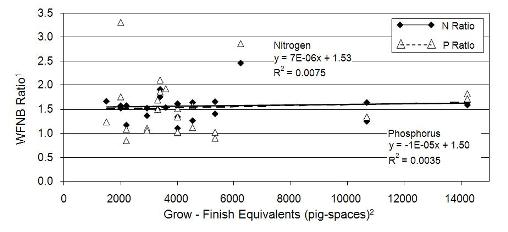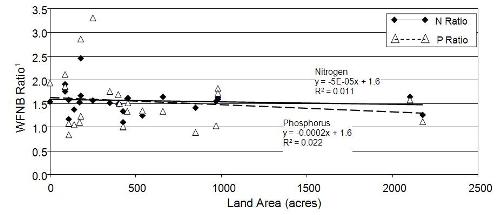| Take Home Message |
| Both the number of animals and the size of the land base were not observed to influence WFNB. These pork producers have adopted nutrient management strategies that have diminished the importance of size relative to the management of nutrients. These results call into question the value of determining which facilities need a permit based upon size. |
Click here for introduction to WFNB
Farm size as measured by animal capacity is often the basis for determining which animal production facilities will be regulated and to what extent. For swine operations, a threshold of 2400 pig capacity (finishing and reproductive herd) often triggers the requirement of a federal permit under Concentrated Animal Feeding Operations rules of the National Pollutant Discharge Elimination System program. However, for the 13 farms involved in this study of Whole Farm Nutrient Balance (WFNB), size proved to be a poor indicator of the efficiency of nutrient utilization or potential for nutrient losses from the farm.
Whole Farm Nutrient Balance (WFNB) vs. Swine Facility Size
Size of the pig operation does not explain the variability in WFNB as illustrated by the flat regression lines in Figure 1 for both nitrogen (N) and phosphorus (P) balances. Based upon an analysis of WFNB, three farms experience N or P whole farm balance ratios of 2 to 1 or greater. They included a 2000-head and a 3,400-head finisher, as well as a 6,200 sow and finish facility. These results suggest that farm size has little impact on the efficiency with which nutrients can be managed.

1 WFNB Ratio is a ratio of all nutrients, N and P for this summary, that enter the farm (inputs) to all nutrients that exit the farm as managed products (managed outputs). See WFNB Introduction for a more complete explanation.
2 Grow finish equivalents included nursery pigs and sows. Nursery pigs and sows were converted to a grow-finish equivalent based upon a comparison of average feed intake.
WFNB vs. Cropland Base
Access to a larger land base has often been associated with better utilization of manure nutrients. However, producers have found options for managing manure in situations where the land base is insufficient. In one of the case studies a farm with no land base had a WFNB of 2.1, similar to other producers with much larger land bases. Data from the 13 case farms (Figure 2) demonstrates that access to greater land areas does not result in improved efficiency of nutrient utilization by the participating swine farms.
Manure export was used by seven of the 13 producers in one or more years as a means of accessing land base that they do not own or manage. Others employed diets low in crude protein or phosphorus to partially compensate for limited land access. These modifications to the overall farm’s management of nutrients resulted in a level of WFNB that does not change with the size of the land base owned or managed by the participating producers.

1 WFNB Ratio is a ratio of all nutrients, N and P for this summary, that enter the farm (inputs) to all nutrients that exit the farm as managed products (managed outputs). See WFNB Introduction for a more complete explanation.
2 Grow finish equivalents included nursery pigs and sows. Nursery pigs and sows were converted to a grow-finish equivalent based upon a comparison of average feed intake.
The concentration of animals to the land base is also an important consideration and is reviewed in a separate fact sheet accessible from the Introductory Page.
Results of On-Farm Measurement of WFNB
Return to Introductory Page for WFNB Resources
Authors: Rick Koelsch, University of Nebraska; Joe Lally, Iowa State University; Alan Sutton, Purdue University
This project was funded by The National Pork Board Project

